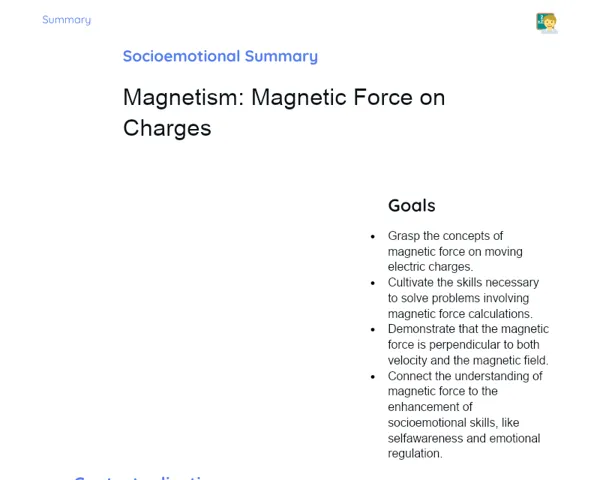Goals
1. Understand the concept of uniform circular motion.
2. Calculate angular variations, period, and angular velocity in uniform circular motion.
3. Apply the concepts of uniform circular motion in practical situations and the job market.
Contextualization
Uniform circular motion (UCM) is something we come across frequently in our everyday lives, like the rotation of a car's wheels or the whirring of a ceiling fan. Grasping this type of motion is crucial for developing technologies that incorporate rotating components and for examining physical systems that follow circular paths. For instance, electric motors leverage UCM to transform electrical energy into mechanical motion, making them indispensable in both the automotive sector and household devices. Moreover, satellites orbiting our planet adhere to trajectories that can effectively be analyzed through UCM principles, underscoring the importance of this knowledge in the aerospace field.
Subject Relevance
To Remember!
Uniform Circular Motion (UCM)
Uniform Circular Motion is the motion of an object moving along a circular path at a steady angular velocity. This type of motion is characterized by its repetitive and predictable nature, where the object's speed remains constant in magnitude while its direction continuously changes as it travels along the circular path.
-
Constant Angular Velocity: In UCM, the angular velocity—the rate of change of angle over time—stays constant.
-
Circular Path: The object travels along a circular pathway, maintaining a fixed distance from the center of the circle.
-
Period and Frequency: The period signifies the time it takes for the object to make one complete revolution, while frequency indicates how many complete revolutions occur in a given period.
Angular Variation
Angular variation refers to the measure of the angle an object moves through during circular motion. This is usually quantified in radians and is a vector quantity, meaning it has both magnitude and direction.
-
Measured in Radians: Angular variation is expressed in radians, where 2π radians equals one complete revolution.
-
Relation to Linear Displacement: Angular variation relates directly to linear displacement through the formula s = rθ, where s denotes linear displacement, r is the radius of the path, and θ signifies angular variation.
-
Importance in Kinematics: Angular variation is essential for describing an object's position in circular motion and for calculating other kinematic quantities like angular velocity and angular acceleration.
Period and Angular Velocity
The period represents the time taken for an object to complete one full revolution within its circular path. Angular velocity, on the other hand, is the rate of change of the angular position of the object over time, measured in radians per second (rad/s).
-
Period (T): This is the time an object takes to accomplish one full revolution. It's the reciprocal of frequency (T = 1/f).
-
Angular Velocity (ω): This indicates how quickly the angle changes over time. It can be calculated using the formula ω = 2π / T.
-
Relation to Circular Motion: Angular velocity is key for determining the speed of circular motion and for understanding centripetal forces and other dynamic aspects of motion.
Practical Applications
-
Electric Motors: These utilize Uniform Circular Motion to convert electrical energy into mechanical motion, vital for the functioning of machines in industries and household appliances.
-
Orbiting Satellites: Satellites orbit around the Earth following circular paths, making an understanding of UCM essential for orbit calculations and maintaining trajectory stability.
-
Gears and Transmissions: Many mechanical systems, such as those found in automobiles, apply UCM concepts in designing gears and transmission systems to ensure smooth and efficient operation.
Key Terms
-
Uniform Circular Motion (UCM): The movement of an object along a circular trajectory with a constant angular velocity.
-
Angular Variation: The measure of the angle through which an object moves in circular motion, generally stated in radians.
-
Period (T): The time it takes for an object to complete one full revolution along its circular course.
-
Angular Velocity (ω): The rate of change of an object's angular position concerning time, measured in radians per second.
Questions for Reflections
-
How can a deeper understanding of uniform circular motion lead to the development of more efficient and innovative technologies?
-
In what ways does angular variation connect to the functioning of common everyday devices like fans and electric motors?
-
What importance does understanding period and angular velocity hold for the fields of mechanical engineering and aerospace?
Practical Challenge: Calculating the Angular Velocity of a Fan
In this mini-challenge, you will apply the concepts of angular variation, period, and angular velocity to determine the angular velocity of a household fan.
Instructions
-
Select a fan from your home.
-
Turn the fan on to its maximum speed.
-
Using a stopwatch, time how long it takes for a single fan blade to make 10 complete revolutions.
-
Calculate the period (T) by dividing the total time recorded by the number of revolutions (10).
-
Using the angular velocity formula (ω = 2π / T), find out the angular velocity of the fan.
-
Note down your observations and calculations on a piece of paper.

